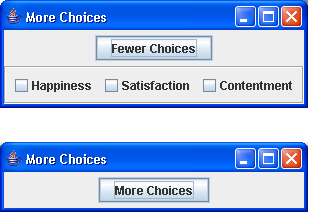Demo to show a way of having More Choices or Less Choices

/*
* Copyright (c) Ian F. Darwin, http://www.darwinsys.com/, 1996-2002.
* All rights reserved. Software written by Ian F. Darwin and others.
* $Id: LICENSE,v 1.8 2004/02/09 03:33:38 ian Exp $
*
* Redistribution and use in source and binary forms, with or without
* modification, are permitted provided that the following conditions
* are met:
* 1. Redistributions of source code must retain the above copyright
* notice, this list of conditions and the following disclaimer.
* 2. Redistributions in binary form must reproduce the above copyright
* notice, this list of conditions and the following disclaimer in the
* documentation and/or other materials provided with the distribution.
*
* THIS SOFTWARE IS PROVIDED BY THE AUTHOR AND CONTRIBUTORS ``AS IS''
* AND ANY EXPRESS OR IMPLIED WARRANTIES, INCLUDING, BUT NOT LIMITED
* TO, THE IMPLIED WARRANTIES OF MERCHANTABILITY AND FITNESS FOR A PARTICULAR
* PURPOSE ARE DISCLAIMED. IN NO EVENT SHALL THE AUTHOR OR CONTRIBUTORS
* BE LIABLE FOR ANY DIRECT, INDIRECT, INCIDENTAL, SPECIAL, EXEMPLARY, OR
* CONSEQUENTIAL DAMAGES (INCLUDING, BUT NOT LIMITED TO, PROCUREMENT OF
* SUBSTITUTE GOODS OR SERVICES; LOSS OF USE, DATA, OR PROFITS; OR BUSINESS
* INTERRUPTION) HOWEVER CAUSED AND ON ANY THEORY OF LIABILITY, WHETHER IN
* CONTRACT, STRICT LIABILITY, OR TORT (INCLUDING NEGLIGENCE OR OTHERWISE)
* ARISING IN ANY WAY OUT OF THE USE OF THIS SOFTWARE, EVEN IF ADVISED OF THE
* POSSIBILITY OF SUCH DAMAGE.
*
* Java, the Duke mascot, and all variants of Sun's Java "steaming coffee
* cup" logo are trademarks of Sun Microsystems. Sun's, and James Gosling's,
* pioneering role in inventing and promulgating (and standardizing) the Java
* language and environment is gratefully acknowledged.
*
* The pioneering role of Dennis Ritchie and Bjarne Stroustrup, of AT&T, for
* inventing predecessor languages C and C++ is also gratefully acknowledged.
*/
import java.awt.BorderLayout;
import java.awt.Container;
import java.awt.Dimension;
import java.awt.event.ActionEvent;
import java.awt.event.ActionListener;
import java.awt.event.WindowAdapter;
import java.awt.event.WindowEvent;
import javax.swing.BorderFactory;
import javax.swing.JButton;
import javax.swing.JCheckBox;
import javax.swing.JFrame;
import javax.swing.JPanel;
/**
* Demo to show a way of having "More Choices/Less Choices" in a pop-up window.
* The secret is to call pack() again each time you add/subtract the bottom
* panel.
*
* @author Ian F. Darwin, http://www.darwinsys.com/
* @version $Id: MoreChoices.java,v 1.3 2004/02/09 03:33:50 ian Exp $
*/
public class MoreChoices extends JFrame {
Container cp;
boolean unsavedChanges = false;
JButton moreOrLessButton;
JPanel moreOrLessPanel;
ActionListener more;
ActionListener less;
/** "main program" method - construct and show */
public static void main(String[] av) {
// create a MoreChoices object, tell it to show up
JFrame jf = new MoreChoices();
jf.setLocation(100, 100); // get away from screen corner,
// since on some OSes a main window at 0,0 may be
// partly obscured (e.g. notebook with PowerPanel
jf.setVisible(true);
}
/** Construct the object including its GUI */
public MoreChoices() {
super("More Choices");
// cp = getContentPane();
cp = this;
cp.setLayout(new BorderLayout());
ButtonsPanel bp = new ButtonsPanel();
cp.add(BorderLayout.NORTH, bp);
// Construct the more/less switcher
less = new ActionListener() {
public void actionPerformed(ActionEvent e) {
cp.remove(moreOrLessPanel);
pack();
moreOrLessButton.setText("More Choices");
moreOrLessButton.removeActionListener(less);
moreOrLessButton.addActionListener(more);
}
};
more = new ActionListener() {
public void actionPerformed(ActionEvent e) {
cp.add(BorderLayout.SOUTH, moreOrLessPanel);
pack();
moreOrLessButton.setText("Fewer Choices");
moreOrLessButton.removeActionListener(more);
moreOrLessButton.addActionListener(less);
}
};
bp.add(moreOrLessButton = new JButton("More Choices"));
// Initial state is to add more choices
moreOrLessButton.addActionListener(more);
moreOrLessPanel = new ChoicesPanel();
// Finally a frame closer
addWindowListener(new WindowAdapter() {
public void windowClosing(WindowEvent e) {
setVisible(false);
dispose();
System.exit(0);
}
});
pack();
}
/**
* The panel that appears when you press More Choices. This is a toy; in a
* real application, this would likely be a separate full "public class".
*/
class ChoicesPanel extends JPanel {
ChoicesPanel() {
setBorder(BorderFactory.createEtchedBorder());
add(new JCheckBox("Happiness"));
add(new JCheckBox("Satisfaction"));
add(new JCheckBox("Contentment"));
}
}
/**
* The Panel that contains the More/Less button. It is just here to override
* getPreferredSize so that we can avoid "jitter" (i.e., the width
* changing); i.e., we must ensure that the main panel and the ChoicePanel
* have the same width
*/
class ButtonsPanel extends JPanel {
public Dimension getPreferredSize() {
// System.out.println("In ButtonsPanel.getPreferredSize()");
// For height, use our normal height
int dHeight = moreOrLessButton.getPreferredSize().height + 5 + 5;
// For witdh, use the included Panel's width
int dWidth = moreOrLessPanel.getPreferredSize().width;
// Combine them; that's the result we need.
return new Dimension(dWidth, dHeight);
}
}
}
Related examples in the same category